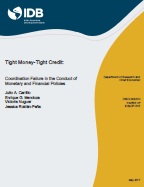Tight Money-Tight Credit: Coordination Failure in the Conduct of Monetary and Financial Policies
Date
May 2017
Quantitative analysis of a New Keynesian model with the Bernanke-Gertler accelerator and risk shocks shows that violations of Tinbergen's Rule and strategic interaction between policymaking authorities undermine significantly the effectiveness of monetary and financial policies. Separate monetary and financial policy rules, with the latter subsidizing lenders to encourage lending when credit spreads rise, produce higher welfare and smoother business cycles than a monetary rule augmented with credit spreads. The latter yields a tight money-tight credit regime in which the interest rate responds too much to inflation and not enough to adverse credit conditions. Reaction curves for the choice of policy-rule elasticity that minimizes each authority¿s loss function given the other authority's elasticity are nonlinear, reflecting shifts from strategic substitutes to complements in setting policy-rule parameters. The Nash equilibrium is significantly inferior to the Cooperative equilibrium, both are inferior to a first-best outcome that maximizes welfare, and both produce tight money-tight credit regimes.



